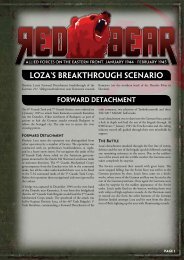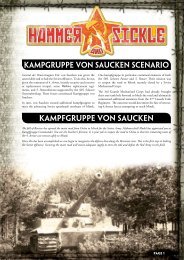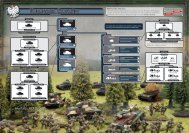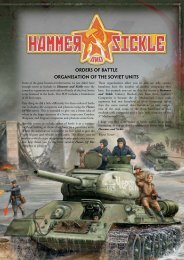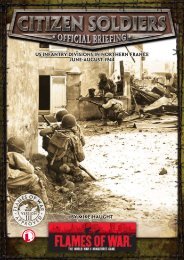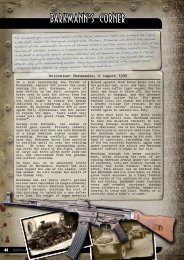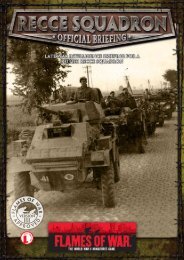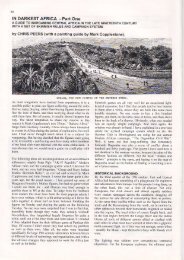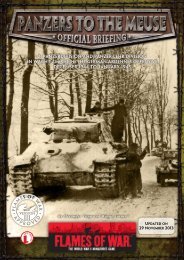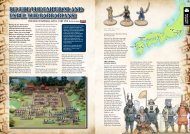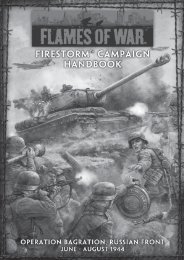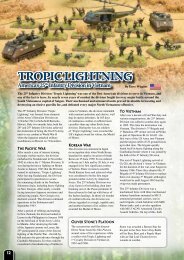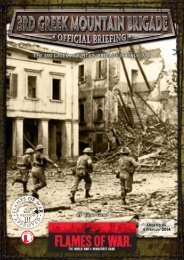Create successful ePaper yourself
Turn your PDF publications into a flip-book with our unique Google optimized e-Paper software.
tribesmen to charge when fired upon by<br />
the horse artillery. Perhaps the Afghans<br />
must test against their leadership<br />
quality to restrain themselves, or will<br />
automatically charge having taken a set<br />
number <strong>of</strong> casualties.<br />
Theatre <strong>of</strong> Operations<br />
during the second<br />
Afghan <strong>War</strong>, 1878-81<br />
As a skirmish game, the Battle <strong>of</strong><br />
Futtehabad <strong>of</strong>fers several possibilities.<br />
One might feature the surviving<br />
tribesmen attempting to break out <strong>of</strong><br />
the trap into which they had charged,<br />
making for an interesting reversal <strong>of</strong><br />
the traditional image <strong>of</strong> the last few<br />
invaders conducting a last stand or<br />
desperate break out against a larger<br />
force <strong>of</strong> natives. Alternately, the idea <strong>of</strong><br />
the impassable streams on either <strong>of</strong> the<br />
battlefield could be explored – perhaps<br />
a small party (<strong>of</strong> Guides or Ghurkhas) is<br />
caught reconnoitring a flank, and must<br />
escape to inform their commander <strong>of</strong><br />
their findings.<br />
Gaming the Massacre<br />
at the Residency<br />
While it might be considered poor taste<br />
to game what was, in effect, a slaughter,<br />
the fight the Guides put up against<br />
the attackers was a heroic act and the<br />
sort <strong>of</strong> deed that wargamers have been<br />
recreating as long as there have been<br />
wargamers. The attack would best<br />
be represented at the skirmish scale,<br />
focusing perhaps on the defence <strong>of</strong> the<br />
residency grounds, attempts to break<br />
out, or on the final charge. A ‘realistic’<br />
objective would be to get a messenger<br />
out to appeal for aid rather than to<br />
repel the attackers, for that would<br />
be all but impossible. The defenders<br />
would therefore win not by inflicting<br />
casualties, but by holding <strong>of</strong>f the assault<br />
long enough for a messenger to escape.<br />
Above: Key Locations in the Second Afghan <strong>War</strong> - 1. Maiwand, 2. Kandahar, 3. Kabul, 4.<br />
Charasia, 5. Ahmed Khel, 6. Peiwar Kotal, 7. Fatehbad, 8. Landi Kotal, 9. Ali Masjid<br />
Map from Essential Histories 40 - The Anglo-Afghan <strong>War</strong>s1839-1919,<br />
© Osprey Publishing Ltd. www.ospreypublishing.com<br />
Gaming the Battle<br />
<strong>of</strong> Charasia<br />
As a wargame, this battle would be<br />
similar to the Battle <strong>of</strong> Ali Masjid, but<br />
the situation is made more pressing for<br />
the British because a large number <strong>of</strong><br />
Afghan tribesmen are closing on their<br />
rear. They must therefore defeat the<br />
main Afghan line within a set time limit,<br />
at which point it is assumed that the<br />
tribesmen enter play and change things<br />
significantly.<br />
As a skirmish, the action could focus on<br />
the rear, with small parties defending<br />
the baggage train against vengeful<br />
tribesmen. Perhaps the wagons,<br />
camels, elephants, etc. are defended<br />
by a mixed scratch force <strong>of</strong> sick and<br />
wounded British and Indian troops,<br />
plus larger numbers <strong>of</strong> civilians. Such<br />
confrontations were frequent throughout<br />
the course <strong>of</strong> the war, with tribesmen<br />
constantly harrying British supply lines.<br />
In this particular case, the skirmish is<br />
part <strong>of</strong> a larger action.



